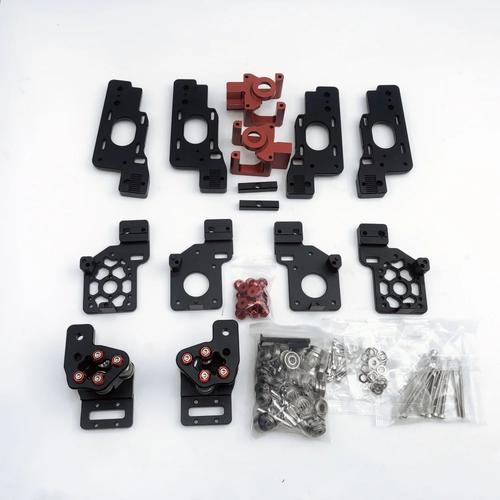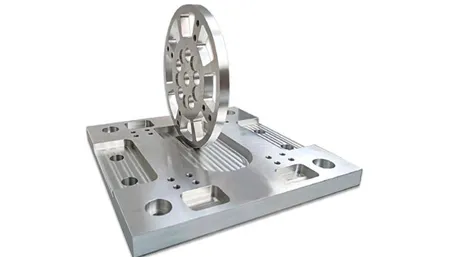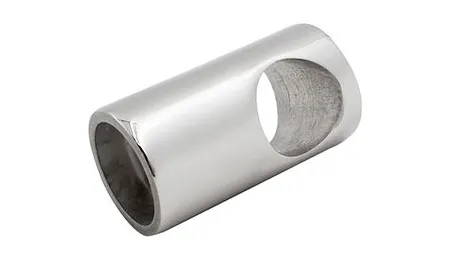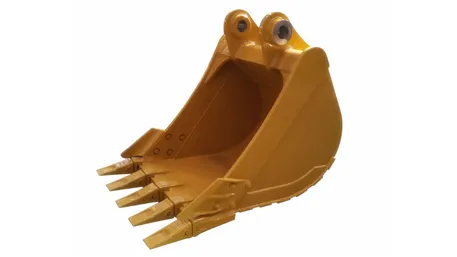CNC aerospace parts are precision-engineered components manufactured using Computer Numerical Control (CNC) machining for aircraft, spacecraft, and aerospace systems. These parts demand extreme accuracy (±0.001mm), high durability, and compliance with strict industry standards, as they operate in harsh environments (extreme temperatures, pressure, vibration). CNC machining enables the production of complex, lightweight, and high-strength parts from advanced materials, critical for safety, fuel efficiency, and performance in aviation and space exploration.

Detailed Analysis of CNC Aerospace Parts
1. Technical Significance in Aerospace
Aerospace is one of the most demanding sectors for manufacturing, requiring parts that balance strength, lightweight properties, and reliability under extreme conditions. CNC machining is indispensable here due to its unique capabilities:
- Tight Tolerances: Aerospace components like turbine blades or fuel system valves require tolerances as low as ±0.001mm to ensure aerodynamic efficiency and leak-free operation. CNC machines achieve this via high-precision servo motors, linear scales, and advanced controllers (e.g., Fanuc 31iB) that minimize positional errors.
- Complex Geometries: Modern aircraft and rockets feature intricate designs—from curved wing ribs to hollow turbine casings—that traditional manufacturing (casting, forging) cannot produce accurately. 5-axis CNC machines, which rotate parts along three linear (X, Y, Z) and two rotational (A, B) axes, create these shapes in a single setup, reducing errors from multiple operations.
- Material Versatility: CNC machining handles the high-performance materials critical to aerospace, including titanium alloys, superalloys, and composites, which are difficult to shape with conventional methods due to their strength and heat resistance.
2. Key Materials for CNC Aerospace Parts
Aerospace materials are chosen for strength-to-weight ratio, heat resistance, and corrosion resistance, with CNC machining adapted to their unique properties:
-
Titanium Alloys (Ti-6Al-4V):
The gold standard for aerospace structural parts (frames, brackets) and engine components, Ti-6Al-4V offers high strength (900 MPa tensile strength) and low density (4.43 g/cm³). CNC machining titanium requires slow feeds (50–200 mm/min) and high coolant pressure (70–100 bar) to manage its low thermal conductivity, which traps heat at the cutting zone and causes tool wear. Carbide tools with TiAlN coatings are mandatory to resist abrasion. -
Nickel-Based Superalloys (Inconel 718, Waspaloy):
Used in engine hot sections (turbine blades, combustion chambers), these alloys retain strength at 1,000°C+. Machining Inconel is challenging due to its work-hardening tendency; CNC programs use light cuts (0.1–0.3mm depth) and low speeds (50–150 RPM) to avoid excessive tool stress. Ceramic or cubic boron nitride (CBN) tools are used for finishing to achieve Ra <0.8μm surfaces. -
Aluminum-Lithium Alloys (2195, 2050):
Lighter than traditional aluminum (2.55 g/cm³ vs. 2.7 g/cm³) with high strength, these alloys are used in aircraft fuselages and wings. CNC machining is efficient here, with high spindle speeds (10,000–20,000 RPM) and carbide end mills, though care is taken to avoid chatter in thin-walled sections (<2mm). -
Composites (Carbon Fiber Reinforced Polymer, CFRP):
Used for lightweight structural parts (wing skins, satellite panels), CFRP requires CNC routers with diamond-coated tools to prevent fiber fraying. Machining parameters are optimized to minimize delamination—low feed rates (100–300 mm/min) and high vacuum extraction to remove dust.
3. Common CNC Aerospace Part Types
CNC machining produces a range of critical aerospace components, each with specialized requirements:
-
Engine Components:
- Turbine Blades: CNC-machined from Inconel or single-crystal superalloys, these blades feature complex airfoil shapes with precision cooling holes (0.5–2mm diameter) drilled via EDM or laser. Tolerances on leading/trailing edges are ±0.02mm to ensure airflow efficiency.
- Engine Casings: Titanium or aluminum casings with intricate flanges and bolt holes, machined on 5-axis CNC mills to maintain concentricity and seal tightness, preventing oil leaks or gas escape.
-
Structural Parts:
- Wing Ribs & Spars: Aluminum-lithium or CFRP components with thin walls (1–3mm) and reinforcing ribs, machined to reduce weight while withstanding aerodynamic loads. CNC programs use adaptive toolpaths to avoid vibration in thin sections.
- Landing Gear Components: High-strength steel (4340) or titanium parts (axles, struts) with tight tolerances on bearing surfaces (±0.005mm) to ensure smooth operation and safety during takeoff/landing.
-
Avionics & Systems:
- Instrument Panels: Lightweight aluminum enclosures with precision cutouts for displays and sensors, machined to protect sensitive electronics from vibration and electromagnetic interference (EMI).
- Fuel System Parts: Stainless steel or titanium valves, manifolds, and filters with micro-machined channels (0.1–1mm) to control fuel flow, requiring Ra <0.4μm surfaces to prevent clogging.
-
Spacecraft Components:
- Rocket Nozzles: Copper or niobium alloys machined for high heat resistance, with internal cooling channels to withstand 3,000°C exhaust gases during launch.
- Satellite Brackets: Titanium or CFRP parts with low mass and high rigidity, machined to precise dimensions to align solar panels and antennas.
4. Manufacturing Process for CNC Aerospace Parts
The production of CNC aerospace parts follows a rigorous, standardized workflow to ensure quality and compliance:
-
Design & Engineering:
Parts are designed using CAD software (CATIA, Siemens NX) with input from aerodynamic and structural analysis (FEA). Designs prioritize lightweighting (hollow sections, lattice structures) and ease of machining. CAM software (Mastercam, Esprit) generates toolpaths optimized for material and geometry—e.g., spiral toolpaths for turbine blades to reduce scallop height. -
Material Preparation:
Raw materials arrive with full traceability (certificates of conformance, heat treatment records) to meet aerospace standards (e.g., AMS 4911 for Ti-6Al-4V). Billets or sheets are cut to near-net shape to minimize machining time and waste. -
CNC Machining:
- Roughing: Removes 70–90% of excess material using large carbide end mills (10–20mm) at moderate speeds. For titanium, roughing uses coolant-through tools to dissipate heat.
- Semi-Finishing: Refines dimensions with smaller tools (5–10mm), ensuring critical features are within ±0.01mm of final specs.
- Finishing: Achieves final tolerances and surface finishes using micro-tools (1–3mm) and slow feeds. 5-axis machines contour complex surfaces like turbine airfoils in one pass.
-
Post-Processing:
- Heat Treatment: Parts like Inconel turbine blades undergo solution annealing and aging to enhance strength; titanium parts may be β-annealed for toughness.
- Surface Treatments: Anodizing (aluminum) for corrosion resistance, or plasma spray coatings (turbine parts) for heat protection.
- Deburring: Critical for safety—sharp edges are removed via robotic deburring or abrasive flow machining to prevent fatigue cracks.
-
Quality Inspection:
- Dimensional Checks: CMMs with laser scanners verify tolerances; optical comparators inspect surface finish.
- Non-Destructive Testing (NDT): X-ray or ultrasonic testing detects internal defects; dye penetrant testing checks for surface cracks.
- Certification: Parts are documented with material traceability, machining records, and inspection reports to meet AS9100, FAA, or EASA requirements.
5. Industry Applications & Standards
CNC aerospace parts serve diverse aerospace sectors, each with strict standards:
- Commercial Aviation: Parts for Boeing 787 or Airbus A350 prioritize fuel efficiency—lightweight aluminum-lithium fuselages and titanium engine components reduce emissions. Compliance with FAA Part 25 (airworthiness standards) is mandatory.
- Military Aviation: Fighter jets (F-35) and helicopters use CNC-machined titanium structural parts and Inconel engine components to withstand high-G forces and combat environments. ITAR (International Traffic in Arms Regulations) governs material traceability.
- Space Exploration: NASA’s Space Launch System (SLS) and SpaceX rockets use CNC-machined copper rocket nozzles and CFRP fairings. Parts must survive extreme vibration during launch and vacuum in space.
- UAVs & Drones: Smaller aerospace systems use aluminum and composite CNC parts for lightweight, long-endurance flight, with rapid prototyping via CNC for iterative design.
6. Challenges & Innovations
- Tool Wear: Machining hard alloys increases tool costs; innovations like AI-driven adaptive machining adjust feeds/speeds in real time to extend tool life by 30–50%.
- Cost Pressures: High materials and precision drive up costs, but multi-axis machining reduces setup time, and near-net-shape forging minimizes material waste.
- Sustainability: Dry machining (using air or minimum quantity lubrication) for aluminum reduces coolant waste; recycling of titanium swarf lowers material costs.
CNC aerospace parts are the backbone of modern aviation and space exploration, enabling the precision, durability, and efficiency demanded by the industry. By combining advanced materials, multi-axis machining, and rigorous quality control, CNC technology ensures these critical components meet the strictest safety and performance standards.






